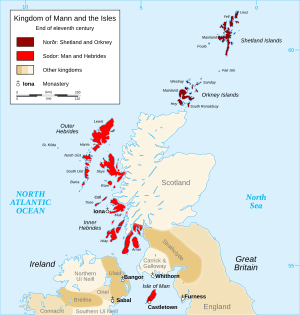Thorfinn the Mighty facts for kids
Quick facts for kids
Thorfinn Sigurdsson
|
|
|---|---|
| Earl of Orkney | |
| Title held | c. 1016 to c. 1065. Jointly with Brusi Sigurdsson and Einar Sigurdsson to 1020, with Brusi to 1031, alone to 1036, with Rögnvald Brusason 1036 to 1046, alone to c. 1065 |
| Predecessor | Sigurd Hlodvirsson |
| Successor | Paul and Erlend Thorfinnsson |
| Native name | Þorfinnr inn riki - "Thorfinn the Mighty" |
| Born | 1009? |
| Died | c. 1065 |
| Noble family | Norse Earls of Orkney |
| Spouse | Ingibiorg Finnsdottir |
| Issue | Paul and Erlend Thorfinnsson |
| Father | Sigurd Hlodvirsson |
| Mother | A daughter of Máel Coluim II of Scotland |
Thorfinn Sigurdsson (born around 1009, died around 1065) was a powerful leader in the 11th century. He was known as Thorfinn the Mighty in Old Norse. He held the title of Jarl of Orkney, which was like being a powerful ruler or count.
Thorfinn was the youngest of five sons of Jarl Sigurd Hlodvirsson. His mother was a daughter of King Malcolm II of Scotland. He ruled Orkney for many years, sometimes alone and sometimes with his brothers or his nephew, Rögnvald Brusason. Thorfinn married Ingibiorg Finnsdottir.
Ancient stories like the Heimskringla and the Orkneyinga Saga say that Thorfinn was the strongest of all the Orkney jarls. He controlled large areas beyond the Northern Isles. The Orkneyinga Saga tells many stories about his wars, especially with a "King of Scots" named Karl Hundason. Later in his life, Thorfinn went on a long journey to Rome. He also helped make Orkney and Shetland a stronger part of Christendom. After he died, his sons Paul and Erlend became the next earls.
Contents
Early Life and Family
Thorfinn was the youngest son of Earl Sigurd Hlodvirsson. He was the only son from Sigurd's marriage to a daughter of King Malcolm II of Scotland. His older half-brothers were Einar, Brusi, and Sumarlidi. Another brother, Hundi, died young in Norway.
Earl Sigurd, Thorfinn's father, died in a battle in Ireland in 1014. Before this, he had sent Thorfinn, who was only five years old, to live with his grandfather, the King of Scots. When Sigurd died, Thorfinn's older half-brothers divided Orkney and Shetland among themselves. King Malcolm made Thorfinn the ruler of Caithness and Sutherland in Scotland. He also gave Thorfinn Scottish advisors to help him rule.
The Orkneyinga Saga describes Thorfinn as a very strong and tall man. It says he had a black head of hair and sharp features. He was known for being brave and a good leader in battle. He wanted fame and fortune.
Sharing Power in Orkney
With Einar and Brusi
It was common for the Norse earls of Orkney to share their power. Sumarlidi, one of Thorfinn's half-brothers, died not long after their father. Einar then took Sumarlidi's share, ruling two-thirds of the earldom. Brusi ruled the remaining third. Einar was not very popular. He demanded high taxes and military service from the farmers. The saga says Einar was a "great bully," but Brusi was "well liked."
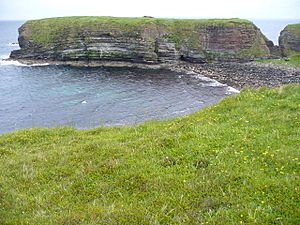
Farmers in the islands did not like Einar's rule. Their leader was Thorkel Amundason. Thorkel had to flee to Thorfinn's court in Caithness to be safe. Thorkel became Thorfinn's foster-father, which is why he was called "Thorkel Fosterer."
After Sumarlidi died, Thorfinn wanted his share of Orkney and Shetland. Brusi was willing to give it to him. But Einar, who was strong and greedy, refused. Thorfinn and Einar both started gathering armies. But Earl Brusi stepped in and made peace. He convinced Einar to give Thorfinn what he wanted. They also agreed that if Brusi or Einar died, the other brother would get their share.
Thorfinn made Thorkel Fosterer his tax collector in the islands. But Einar still held a grudge against Thorkel. So, Thorkel had to leave the islands again, fearing for his life. He went back to Thorfinn in Caithness. Thorkel then traveled to Norway with Thorfinn's support. He met with King Olaf Haraldsson. King Olaf welcomed Thorkel because he had his own reasons to dislike Einar. Olaf also invited Thorfinn to Norway, and Thorfinn was welcomed too.
Thorfinn and Thorkel returned to Orkney. They found Einar gathering an army against them. Brusi again made peace. They agreed that Einar and Thorkel would have a feast together. In October 1020, Einar went to Thorkel's hall. Thorkel's spies told him that Einar had planned traps for him. So, Thorkel arrived secretly and killed Einar. Thorkel then escaped to Norway.
With Brusi
Einar's death did not end the arguments over the earldom. Brusi believed he should get Einar's share. But Thorfinn thought the islands should be divided equally. Thorfinn had the help of his grandfather, King Malcolm. Brusi only had his own forces, so he went to Norway. He asked King Olaf to decide the dispute. Thorfinn also joined him there.
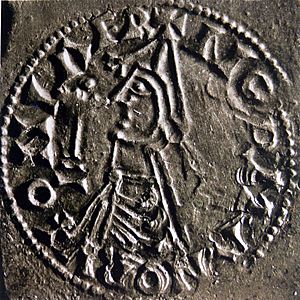
Brusi gave the earldom to King Olaf. Olaf then gave a third of the islands to each brother. He kept a third for himself. Thorfinn tried to avoid accepting Olaf as his overlord. But Olaf threatened to give Thorfinn's share to someone else. Thorfinn agreed to Olaf's plan. After Thorfinn left Norway, Olaf gave Brusi the third share that was in dispute. But Olaf kept Brusi's son, Rognvald, in Norway as a hostage. This happened around 1021.
This arrangement lasted until Olaf was overthrown in 1030. After that, Orkney was attacked by Norwegians and Danes. Brusi agreed to give the King's third share to Thorfinn. In return, Thorfinn would defend the islands. This agreement lasted until Brusi died, sometime between 1030 and 1035. After Brusi's death, Thorfinn became the sole ruler of Orkney. He was a vassal (a ruler who owes loyalty) to the King of Norway. He was also Earl of Caithness, reporting to the King of Scots.
War with Karl Hundason
The Orkneyinga Saga says that Thorfinn had a big fight with Karl Hundason. Karl became "King of Scots" and claimed Caithness. His forces moved north and set up base in Thurso. Thorfinn fought Karl in a sea battle near Deerness in Orkney. Thorfinn won this battle.
Then, Karl's nephew, Mutatan or Muddan, was killed in Caithness by Thorkel Fosterer. Finally, a big battle happened at "Torfness" (likely Tarbat Ness). Karl was either killed or forced to run away. The saga says Thorfinn then marched south through Scotland. He went as far as Fife, burning and taking goods as he went.
Sharing Power with Rognvald
Around 1034, Thorfinn is said to have taken control of the Hebrides. He likely ruled parts of the Kingdom of the Isles until he died.
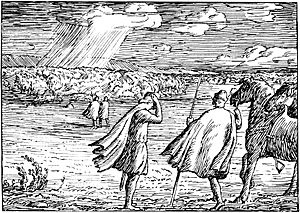
Thorfinn ruled Orkney alone until his nephew Rognvald Brusason returned around 1037. Rognvald had gained the favor of King Magnus "the Good" Olafsson. King Magnus gave Rognvald Brusi's share of the islands. He also gave him the third share that Olaf Haraldsson had claimed. Thorfinn agreed to this division. He presented the transfer of the Norwegian king's share as a gift to Rognvald. This was in return for Rognvald's help in Thorfinn's wars. These wars were fought in the Hebrides and the Irish Sea.
Thorfinn and Rognvald raided many places and gained control over lands around the Irish Sea. They won a big victory near Vatzfjorðr, possibly Loch Vatten on the Isle of Skye. They also raided in England, with mixed results.
Over time, Thorfinn and Rognvald had a falling out. The Orkneyinga Saga tells a detailed story of their war. Their conflict started when Kalf Arnesson and his followers arrived in Orkney. Kalf was the uncle of Thorfinn's wife, Ingibiorg. He had been involved in the death of King Olaf. Kalf had left Norway to escape King Magnus Olafsson.
Thorfinn found it difficult to host Kalf and his men. He asked Rognvald to return the third part of the earldom that had belonged to Einar. Rognvald refused, saying King Magnus should decide. Thorfinn started gathering an army. Rognvald's islanders did not want to fight Thorfinn. So, Rognvald sailed to Norway. King Magnus gave him ships and men.
Rognvald returned to the islands and fought Thorfinn and Kalf Arnesson in a sea battle. At first, the battle went well for Rognvald. But in the end, he was defeated. He had to seek safety with King Magnus again.
King Magnus offered to prepare another expedition for Rognvald. But Rognvald decided to take just one ship and a small, chosen crew. He sailed to Shetland in winter. He learned that Thorfinn was staying on a farm in Orkney with only a few men. Rognvald immediately set out to attack him. Rognvald's men surprised Thorfinn and set the farm on fire. The saga says Thorfinn had to break down a wall and escape. He carried his wife in his arms and fled south to Caithness.
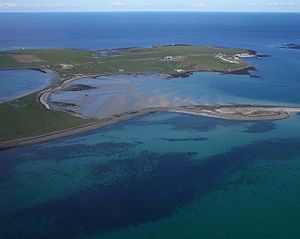
Rognvald ruled in Kirkwall during the winter, thinking Thorfinn was dead. But in the spring, Thorfinn and his men surprised Rognvald. Rognvald was staying on Papa Stronsay. He escaped the house Thorfinn had surrounded. But he was tracked down because his small dog barked. Thorkel Fosterer then killed Rognvald.
The Orkneyinga Saga says Rognvald was "the most popular and gifted" of all the Earls of Orkney. Many people mourned his death.
Journey to Rome
Even with Rognvald dead, Thorfinn was not completely safe. The saga tells of his attempt to make peace with King Magnus Olafsson. Magnus had sworn to get revenge for his men killed by Thorfinn. But Magnus was fighting the Danish king Sweyn Estridsson and died before he could act. Magnus's uncle and successor, Harald Hardrada, was more friendly to Thorfinn. They made peace, and Harald accepted Thorfinn's gifts.
Thorfinn had two sons with his wife Ingibiorg. Unlike some other leaders, he only married once. Also, unlike his brothers, Thorfinn was raised as a Christian. One sign of changes in Orkney was Thorfinn's long journey to Rome. This trip likely started in 1048, after he met King Harald. The saga says he traveled through Saxony. He met Emperor Henry III during his journey. It is also thought he met Archbishop Adalbert of Hamburg-Bremen.
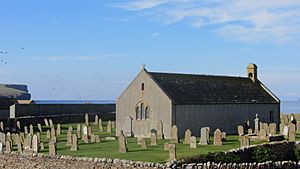
The Orkneyinga saga suggests that the first Bishop of Orkney was appointed around this time, because of Thorfinn's request. The bishop was named Thorulf. The first home for the bishops of Orkney was Thorfinn's new church, Christchurch, at Birsay. This was near the Earl's palace, where Thorfinn lived in his later years.
Death and Legacy
The Orkneyinga saga says Thorfinn died "towards the end" of Harald Sigurdsson's rule. Harald died in 1066. Thorfinn was buried at the Christ Church he had built. He is remembered as "Thorfinn the Mighty." At his most powerful, he controlled all of Orkney and Shetland, the Hebrides, Caithness, and Sutherland. His influence reached across much of northern Scotland. The saga also makes a grander claim: that he controlled seven earldoms in Scotland.
His sons Paul and Erlend became earls after him. His widow, Ingibiorg, later married Malcolm Canmore, who was the King of Scots. St Olaf's saga says that after Thorfinn died, "many of the lands that the earl had taken were lost."
|


